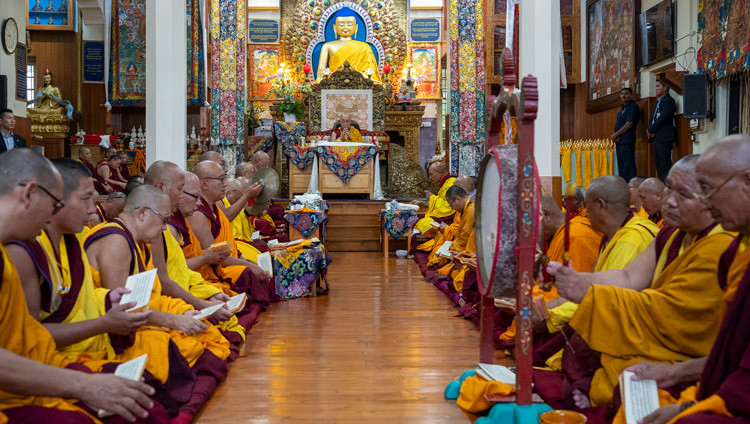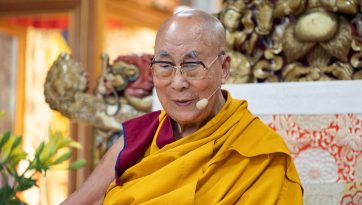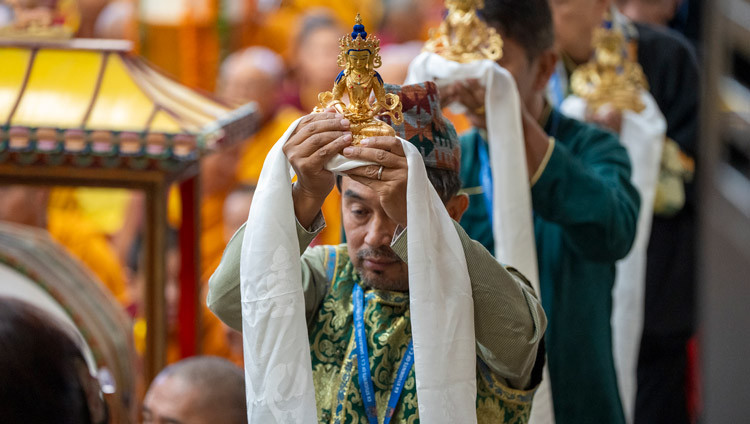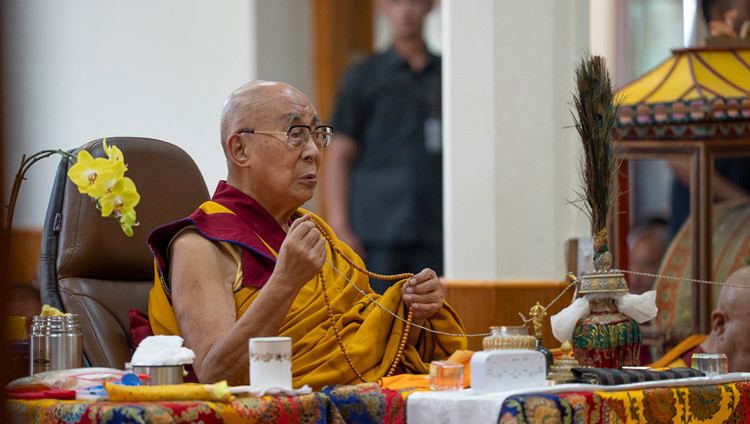Attending Debates at Ganden Jangtsé
December 23, 2019
Mundgod, Karnataka, India – More than 400 members of Dharma Centres abroad linked to Ganden Jangtsé Monastery and friends of the monastery gathered in the audience room next to His Holiness the Dalai Lama’s apartment this morning. A dozen groups clustered around to have their photographs taken with him. Then, all of them sat on the floor before him as he said a few words to them.
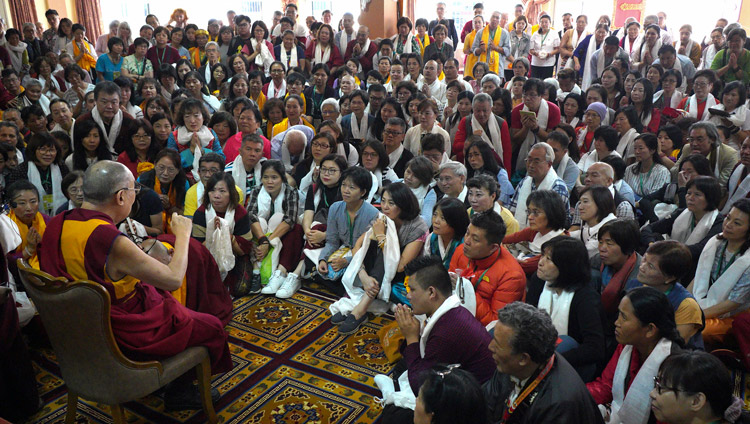
“The 20th century was an era of war and violence,” he told them, “and yet violence is never a solution to problems. It only brings suffering. Understanding that, after the Second World War, French and German leaders de Gaulle and Adenauer initiated a community in Europe that became the European Union. Consequently, peace has prevailed for more than 70 years in much of Europe. This demonstrates that there is real hope of creating a more peaceful world.
“However, to bring about peace in the world, individuals need to bring about peace of mind within themselves. Despite this, the arms trade continues to flourish. Weapons have no other purpose than destruction. The effective way to resolve conflicts is to engage in dialogue. This is why I often make an appeal for the 21st century to become an era of dialogue.
“Sending men off to war is a remnant of the feudal system. No one wishes to give up their lives and in a democratic world, no one should be expected to. Of course, in this context, China is a totalitarian system, whereas India is the world’s most populous democracy.
“I believe that if we make an effort to develop peace of mind within ourselves and cultivate a proper appreciation of the oneness of humanity, we can create a happier, more peaceful world. What we need is common sense—the positive use of intelligence—and warm-heartedness.”
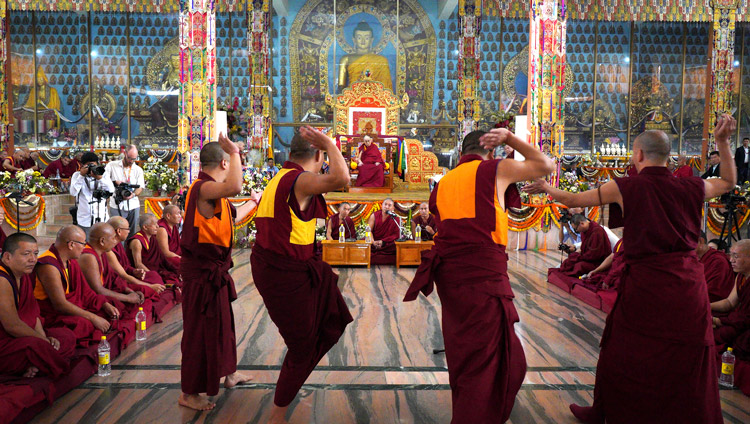
Next, His Holiness went down to the Ganden Jangtsé Assembly Hall, where 2000 monks were gathered, to attend a series of debates. The exchanges were vigorous and energetic as challengers persuaded their respondents to adopt one position only to have to change it and defend another. They touched on topics such as the nature of self and production. They asked whether, from a Prasangika point of view, there is a commonly accepted object in the positions of the Samkhya and Svatantrika schools of thought. They posed such questions as if it is the basis of designation, shouldn’t the continuity of mind qualify as the person?
There was discussion of the non-affirming negative and a comparison of the order in which the Buddha taught the Four Noble Truths to the diagnosis of an ailment. One group of challengers wanted to know what is subjective clear light, receiving a response that it is a consciousness whose intrinsic nature is not contaminated by defilements. Students of logic examined the relationship between fire and smoke, while students of the science of mind discussed definitions of inferential cognition.
A final auspicious verse dedicated the merit of the debates to His Holiness’s long life, to genuine peace in the world and to everyone’s being able to bask in the sunlight of His Holiness’s teachings now and in the future.
“On this visit to South India,” His Holiness observed, “I’ve been able to spend time in two of the Three Seats of Learning. Although we are living in exile, we’ve been quite successful in helping ourselves and others. When we pray for the flourishing of the Dharma, we should remember that that means more than building temples and erecting statues, it means keeping the Buddha’s teachings alive. The ground reality is the Two Truths, conventional and ultimate truth, but deeper practice involves psychology and the use of reason and logic.
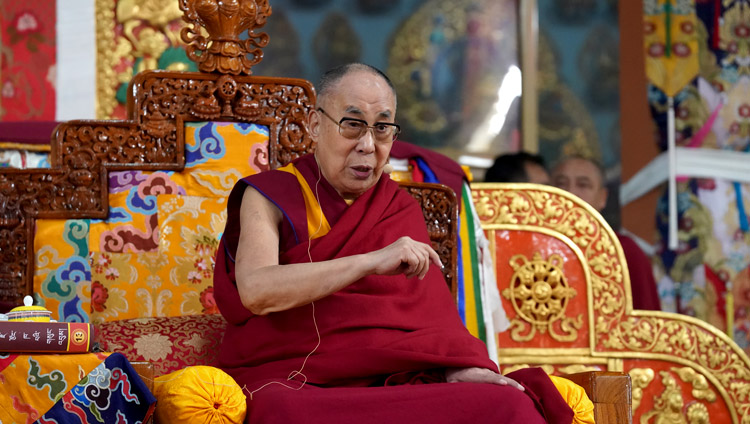
“The Sanskrit tradition that we received from Shantarakshita entailed the use of logic right from the start. Buddhism has spread in many other countries, but only in Tibet was the Nalanda approach, the use of logic and epistemology, upheld. Nevertheless, what we learn through this approach should not remain mere dry words—we need to apply it to achieve transformation within ourselves. If we can do that in a practical way, we can be confident that Buddhist thought and practice will last long.
“I’ll be leaving Mundgod tomorrow, and we’ll hold the Great Prayer Festival in Bodhgaya, where there’ll be more people.
“Let me repeat that whatever you understand through study and debate needs to be integrated within you. You’ve been doing your best; please keep it up. Once you graduate, it would be very good if any of you were able to teach in Tibet.”
His Holiness noted that the people of the Himalayan Region live in free countries. Although opportunities to obtain an education used to be much more limited for them, now they have grown. They can come to train here and take the teachings back home. He observed that Buddhism is about more than conducting rituals. There are deeper explanations akin to science.
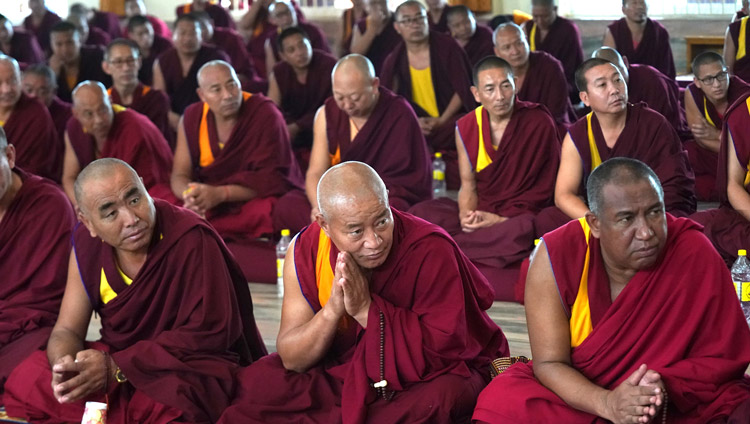
Increasing numbers of Chinese are taking a renewed interest in Buddhism and coming to recognise that an intelligent approach to practice is more effective. Even among hard-line political figures there is some awareness that policy on Tibet needs to be more realistic.
“If you learn Chinese, you’ll be able to help people in mainland China. We follow the Nalanda Tradition and the Chinese have a connection to it through Hsuan Xang. It’ll be very helpful if you not only learn Chinese, but study science too.
“Jé Rinpoché became learned after extensive studies in all the major monasteries in Central Tibet at the time. We are his followers and we need to pay attention to how we pass the entire teachings from one generation to the next. I’m now 84 or 85 years old and most of the monks who left Tibet at the same time are no more.
“See you in Bodhgaya.”
A Prayer for the Flourishing of Jé Rinpoché’s Doctrine by Gungthang Tenpai Drönmé was recited to bring events to a proper conclusion. With endless patience and generosity, His Holiness continued to speak and reach out to people who wanted to make contact with him as he made his way from the temple to the elevator. He touched them, signed books and photographs for them, posed to have his photograph taken with them, and finally smiled and waved before going up to his apartment at the top of the building.

